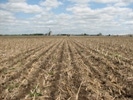
Vertical tillage is a term coined in the last decade. Barry Fisher of the Natural Resources Conservation Service says it has to do with doing tillage vertically instead of horizontally. It usually involves a tool with rolling blades that fracture the soil but doesn't disturb much residue. True vertical tillage tools tend to be run no deeper than two inches, and operated at speeds up tot 8 to 9 miles per hour.
One use you'll likely see soon this spring is someone using one to break the surface in no-till situations. Is it the equivalent of the old 'disk it and air it our so it will dry' maxim? That created lots of soil compaction. Or is it a legitimate method?
The jury was out on that call at a recent no-till meeting. Fisher, the state agronomist, says he hasn't seen data from any tests which indicates what might be happening below the surface if the vertical tool is run over the top and soils are wet underneath.
The other component of this new market is that there are many players, each made somewhat differently. And for as many tools as there are, you can find someone who praises tool A and hates tool B, and another person who hates tool A, and praises tool B. In fact, two farmers visiting each other in the barnlot recently, looking at the host farmer's new vertical tillage tool had a conversation something like this.
"We ran a smaller one last fall and it works great. It leaves the residue spread out and the surface smooth."
Says the second farmer, "I tried that same tool in a smaller width on a demo last fall, and I didn't like it. It was leaving gaps between passes, and churning up soil."
Host farmer continues, "Maybe the dealer didn't have it set level. They're not always right when they come to the field for the first time. Sounds like you might have been running too deep too."
"Maybe," said the visitor. "But I've heard tool B may be the way to go. I might have someone bring one out for me to try."
""Don't waste your time," snapped the host. "I tried one myself and it just isn't what you want. All it is is a heavy disk. And it even costs more than my tool. The idea isn't to disk, it's to break the surface and leave residue on the surface. But it's got to be left level. Set up right, our tool does a good job of leveling."
And so it goes. That conversation has been repeated by more than one set of farmers this winter. Is it differences in soil? Amount of rocks? Dealer setup? Design strategy of the manufacturer? Expectations? Or maybe all of the above? The best answer would seem to be trying one on your own farm, and getting as many opinions as you can before you make a purchase. Set up correctly, most of these tools do the job the manufacturer intends them to do. Every demonstration we've ever been on, even when we were allowed to drive our self and make adjustments, has proven successful.
Good luck making your choice.
About the Author(s)
You May Also Like




